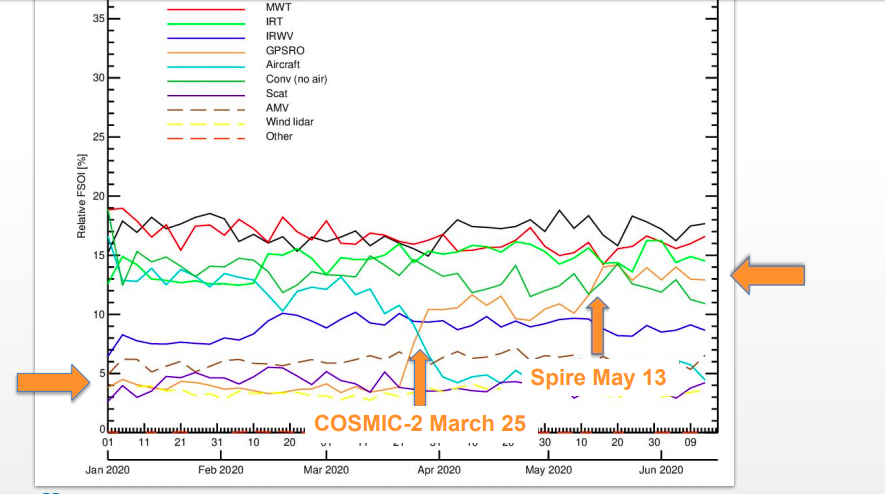SAN FRANCISCO – The U.S. Air Force and European Centre for Medium-Range Weather Forecasts (ECMWF) noted significant improvements in numerical weather prediction models with the recent addition of global navigation satellite system radio occultation datasets.
“It’s been a great year for radio occultation,” Sean Healy, European Centre for Medium-Range Weather Forecasts, said during an Aug. 12 webinar sponsored by Spire Global. “It’s probably been the best year since 2006.”
Meteorologists are obtaining radio occultation soundings, which reveal temperature, pressure and water vapor, from the second six-satellite U.S.-Taiwan Constellation Observing System for Meteorology, Ionosphere and Climate (COSMIC-2) launched in 2019. In addition, commercial data and analytics company Spire Global offered free data earlier this year from its radio occultation satellites to ECMWF, the United Kingdom’s Meteorological Office and the U.S. Air Force to help offset the loss of data captured by commercial aircraft.
When air travel plunged in March as a result of the COVID-19 pandemic, meteorologists saw dramatic reductions in the amount of data provided by atmospheric sensors mounted on commercial aircraft. Around the same time, numerical weather models began taking in thousands of daily COSMIC-2 soundings and Spire Global offered free data from its cubesat constellation.
While it would normally take ECMWF about six months to assess a new dataset, the agency compressed that into six weeks and began feeding Spire Global data into operational forecasts in mid-May. The addition of COSMIC-2 and Spire Global soundings significantly reduced errors in ECMWF’s 24-hour forecasts, Healy said.
In early 2020, radio occultation data helped reduce errors in 24-hour forecasts by about four percent. With the addition of COSMIC-2 and Spire Global data, radio occultation accounted for 13 or 14 percent of error reduction, Healy said.
The Air Force, which works closely with the U.K. Met Office and relies primarily on the U.K. Unified model for global forecasts, also noted improvement.
The Met Office began feeding Spire Global soundings into its model in May. The Air Force was unable to follow suit until early July, when it established a formal agreement with Spire Global.
“The live trials we’ve had over the last couple of months with the Met Office and assimilating the data in the last month at our own Air Force office have shown positive results as expected for global model performance,” said Mike Farrar, Air Force chief scientist for weather operations.
Next, Farrar would like to evaluate the impact of commercial radio occultation data on short term and regional weather forecasts. The impact on forecasts might be even greater, he said, with hourly observations “over a regional box.”
Like ECMWF, the Air Force observed the growing contribution of radio occultation data to forecasts. As that occurred, forecasters produced a chart showing a slight decline in the relative importance of microwave and hyperspectral sounders, although those instruments remained the most important inputs in terms of reducing errors.
“I think you’re seeing with the volume of COSMIC-2 and Spire being added to this mix, that their influences is growing a little bit at the expense of our number one influencing observation type which are the satellite soundings,” Farrar said. “There’s no reason to believe, although I haven’t done the experiment myself, that that the [global navigation satellite system radio occultation] line wouldn’t continue to go up if more soundings were brought in especially if we’re talking about a rapidly updating model.”
Far more research needs to be done including a cost-benefit analysis to determine how much radio occultation data agencies need to improve regional and global models, Farrar said. “What do you get when you add 10,000 profiles globally versus 20,000 versus 30,000,” he asked.
In addition, Farrar asked whether at some future point agencies could “offset the cost of building new multi-hundred-million-dollar satellites with commercial data.”
ECMWF and the Met Office are planning to conduct additional studies including a more detailed analysis of the Spire Global data “that should be useful for European decision makers in the future,” Healy said.
